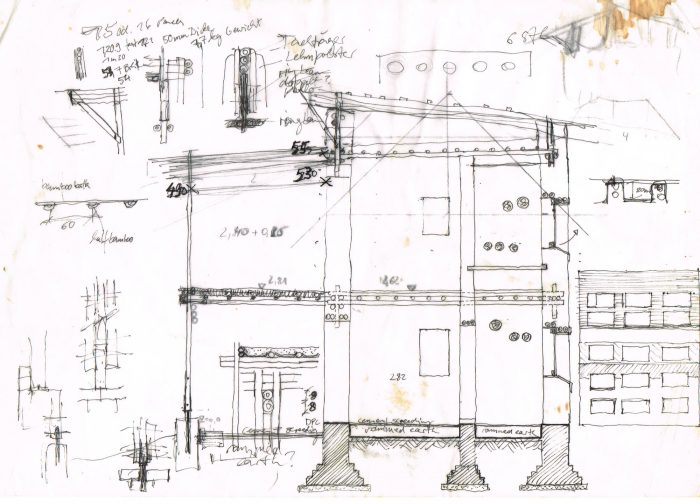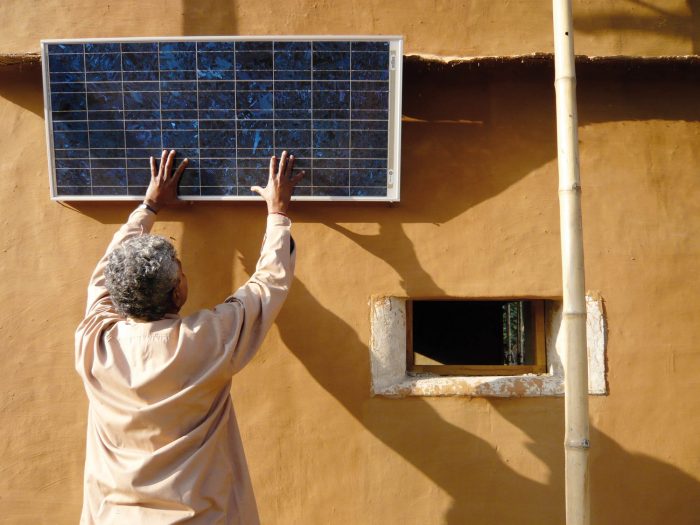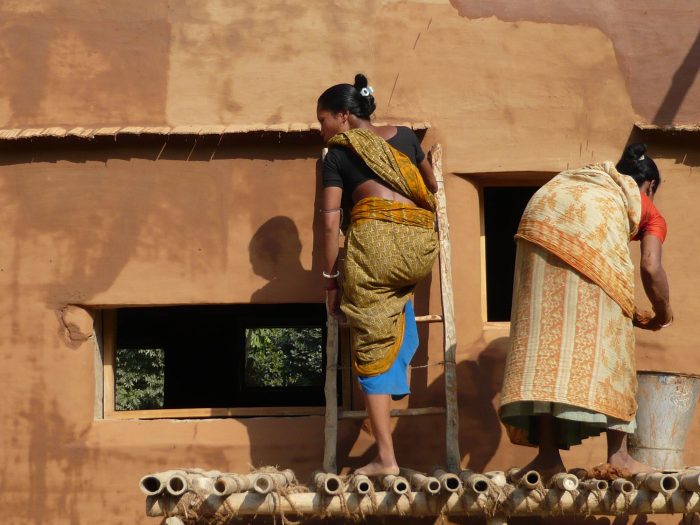一般来说,贫困家庭的生活条件,尤其是发展中国家的贫困家庭的生活条件历来是可持续的。从低收入地位迈向中产阶级,往往会引起方向上的重大转变。随着收入的提高,人们的价值观和生活方式开始发生变化–从自己生产、自给自足走向消费。不常见的、特殊的、异域的东西比本地现有的东西更吸引人,充满活力的梦想和方向是西方的生活方式,而不是长大的传统。
In general the living conditions of poor families, especially in developing countries are traditionally sustainable. It’s the step from low-income status to middle-class that is often causing a major shift in direction. With higher income values and living styles begin to change – from own production and self-sufficiency towards consumption. The uncommon, special and exotic is attracting more than the locally existing, the energizing dream and orientation is the western life-style, not the grown tradition.
中产阶级大多是模仿,寻找适合本民族文化和地域生活方式的试验很少。与其说是行之有效的商业模式–充分利用现有资源,不如说是外部产品的进口和消费越来越重要。因此,经济力量流向了外部市场。对于建筑业来说,这种趋势主要体现在建筑材料的使用变化上。人们不再继续使用泥土,而是购买砖块和水泥,不再使用厚厚的土墙,而是用空调来调节室内气候。
The middle-class is mostly copying, trials to find own ways appropriate to the culture and the regional life-style are rare. Instead of the well-proven business model – to make the best out of existing resources – the import and consumption of external goods is gaining more importance. As a result the economic power flows into external markets. For architecture and the building sector this trend is reflected most of all in the changing usage of building materials. Instead of continuing building with earth, bricks and cement is bought and instead of thick earthen walls the indoor-climate is regulated by air condition.
DESI建筑对这一特殊的挑战做出了反应–它是孟加拉国农村地区一种新的、合适的生活方式的典范:提高生活水平(对于中产阶级–这里是指教师),同时保持传统的可持续性水平。这不是钱的问题,而是对良好的工艺、规划和设计的关注。这是一个公平的建筑–无论社会和财务状况如何–激励传统建筑方法的技术发展,而不是宣传昂贵的进口材料的消费。在水泥抹灰的砖墙之外,一堵狡猾的竹子墙成为了一种声望的象征。这样一来,一个独立的、地方性的身份就自动形成了……。
The DESI building reacts on this particular challenge – it is a model for a new and appropriate way of living in the rural areas of Bangladesh: an improved living standard (for the middle class – in this case teachers) that keeps the traditional level of sustainability. It is not the money that makes the main difference, but the care for a good craftsmanship, planning and design. It’s a fair architecture that – irrespective of the social and financial status – motivates to a technical development of traditional building methods, instead of advertising the consumption of expensive and imported materials. In place of a cement-plastered brick wall, a sophistic woven bamboo wall becomes a sign of prestige. In that way an independent, local identity evolves quite automatically…
DESI建筑是对孟加拉国传统民居的新诠释。在孟加拉国的农村,通常情况下,所有的家庭功能–吃饭、睡觉、洗漱等都是在独立的建筑中进行的。- 吃饭、睡觉、洗漱等各种家庭功能都是在围绕着中央庭院的独立建筑中完成的。然而,DESI建筑试图将工作和生活的所有功能整合到一个单一的结构中。该设计面向的是一种不再与农业挂钩,但仍与农村环境和文化相联系的生活方式。
The DESI building is a new interpretation of the traditional Bangladeshi homestead. Typically in rural Bangladesh all of the various household functions – eating, sleeping, washing, etc. – are performed in separate structures that are built around a central courtyard. The DESI building, however, attempts to incorporate all of the functions of working and living into a single structure. The design is geared toward a lifestyle that is no longer linked with agriculture, but still linked to the rural context and culture.
DESI(Dipshikha Electrical Skill Improvement)是一所电气培训的职业学校。DESI大楼内有两间教室、两间办公室和两间学校教师的住所。教师有一个独立的浴室,有两个淋浴间和两个厕所,学生在一楼有一个带厕所和水槽的浴室设施。
DESI (Dipshikha Electrical Skill Improvement) is a vocational school for electrical training. The DESI building houses two classrooms, two offices, and two residences for the school instructors. There is a separate bathroom with two showers and two toilets for the teachers and a bathroom facility with toilets and sinks on the ground floor for the students.
太阳能电池板产生100%的建筑能源需求。太阳能热水系统提供热水。太阳能电池板还直接为电机提供动力,电机将水从井中抽到水箱中。厕所有自己的双室化粪池。这是孟加拉国首次将卫生设备建在土屋中,证明泥土和竹子的灵活性足以适应现代生活方式的要求。
Solar panels produce 100% of the building’s energy needs. A solar thermal heating system provides warm water. Solar panels also directly power a motor which pumps water from a well into the water tank. The toilets have their own two chamber septic tank. This is the first time that sanitary units have been built into earth houses in Bangladesh, proving that mud and bamboo are flexible enough to accommodate modern lifestyle requirements.
该建筑是高科技和低科技的适当平衡–非常基本的建筑方法与现代替代能源动力系统相结合。由于建筑是被动加热和冷却的,并优化了自然光和通风,相对较小的太阳能电池板和电池系统提供了建筑所需的所有电力。
The building is an appropriate balance of high tech and low tech – very basic building methods are combined with modern, alternative energy power systems. Because the building is passively heated and cooled and optimizes natural light and ventilation, the relatively small solar panel and battery system provides all of the power the building requires.
建筑师: Studio Anna Heringer
占地面积:300 m²
年份:2008年
摄影:Naquib Hossain, B.K.S. Inan
牵头建筑师:Anna Heringer与Dipshikha
Omicron客户:Dipshikha (Non-formal Education Training and Research Society for Village Development), Bangladesh for DESI (Dipshikha Electrical Skill Improvement)
结构工程和技术监督:Stefan Neumann
太阳能安装和电气概念:Jakob Schaub
能源概念:Oskar Pankratz
土结构顾问:Martin Rauch
竹子处理和质量管理顾问:Walter Liese教授
现场监督:Stefan Neumann, Montu Ram Saw, Shoeb Al Rahe。
国家:孟加拉国
Architects: Studio Anna Heringer
Area: 300 m²
Year: 2008
Photographs: Naquib Hossain, B.K.S. Inan
Lead Architect:Anna Heringer with Dipshikha
Omicron Clients:Dipshikha (Non-formal Education Training and Research Society for Village Development), Bangladesh for DESI (Dipshikha Electrical Skill Improvement)
Structural Engineering And Technical Supervision:Stefan Neumann
Solar Installations And Electrical Concept:Jakob Schaub
Energy Concept:Oskar Pankratz
Advisor In Earthen Structures:Martin Rauch
Advisor In Bamboo Treatment And Quality Management:Prof. Walter Liese
Supervision Of Site:Stefan Neumann, Montu Ram Saw, Shoeb Al Rahe
Country:Bangladesh














